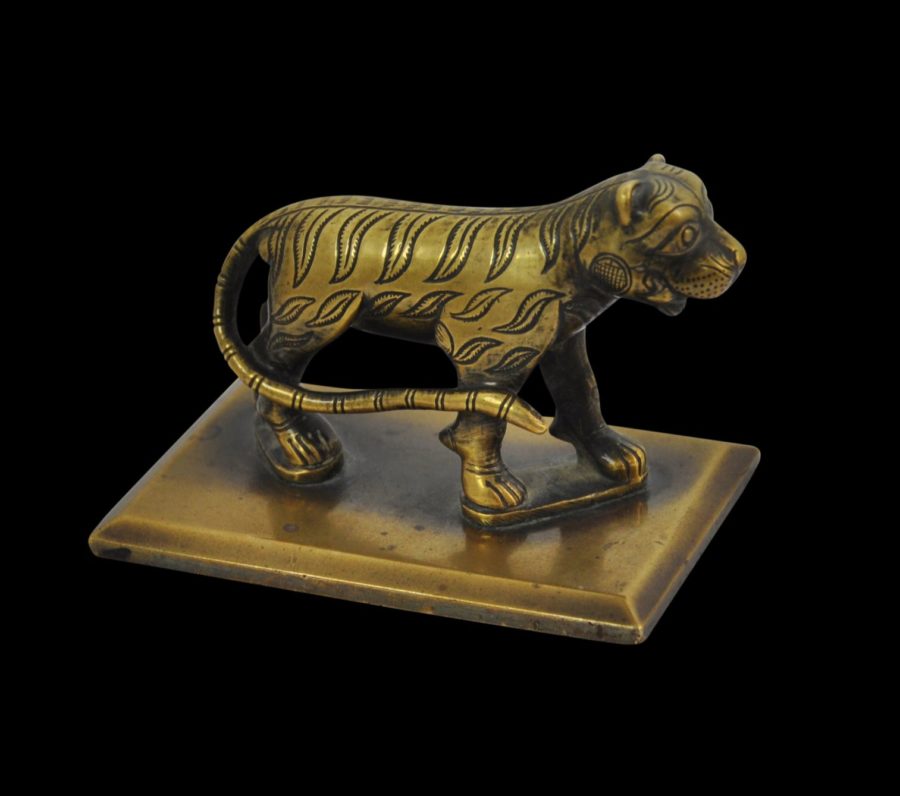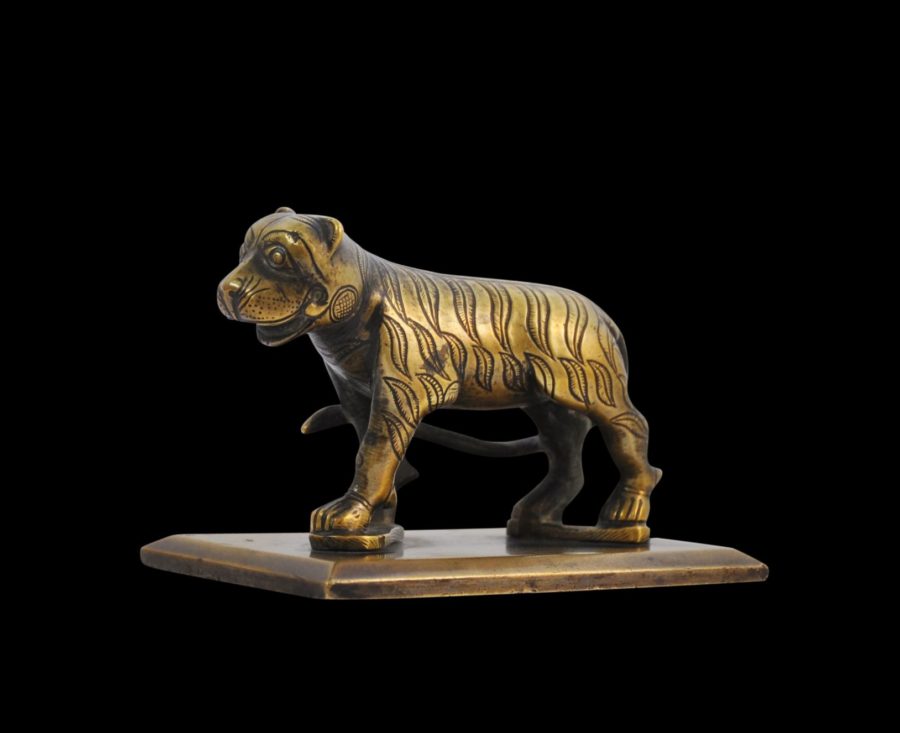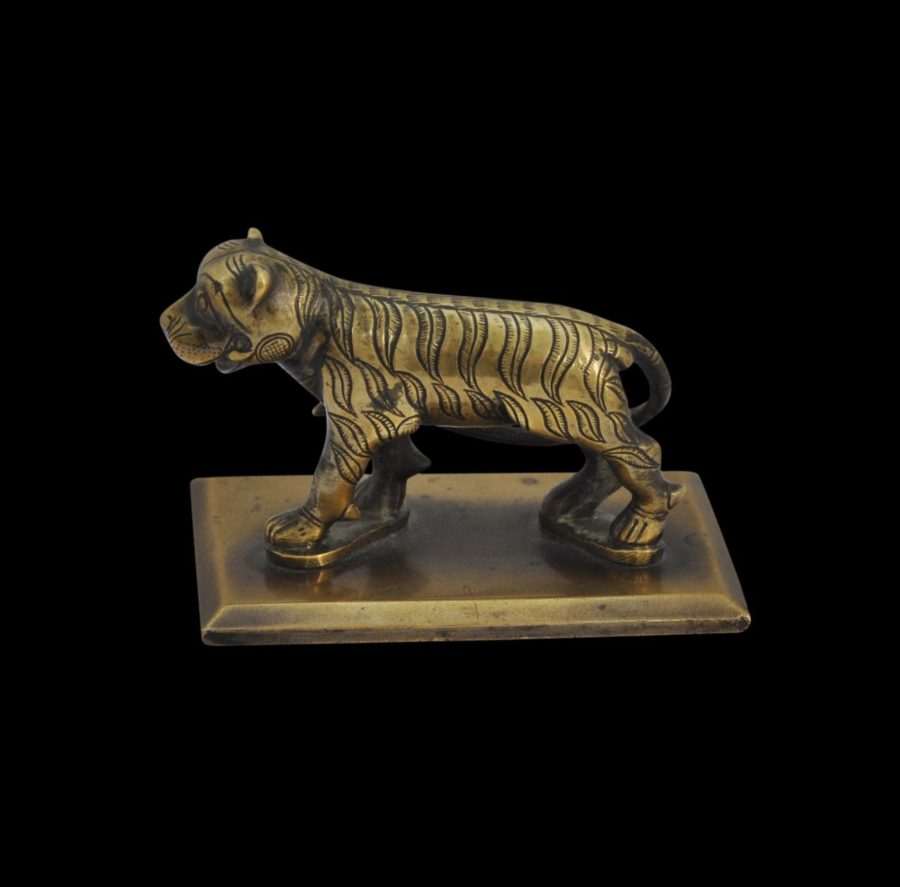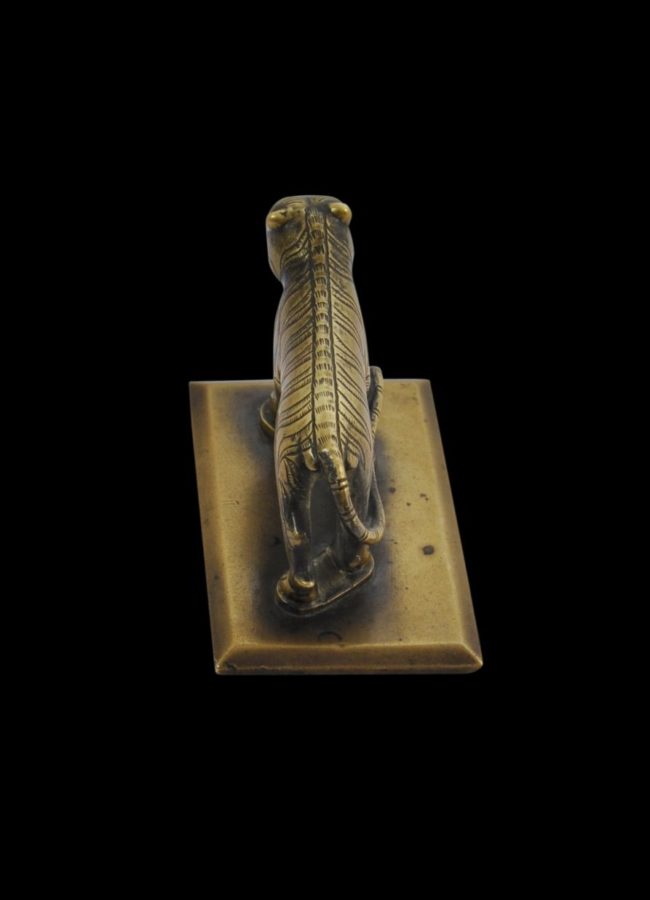This finely cast and engraved model of an Indian tiger probably was produced in Calcutta, the old British colonial capital of India, during the 19th century, to capitalise on the the interest in the near-mythologised status of the South Indian ruler Tipu Sultan, the ‘Tiger of Mysore’ who the British defeated in 1799. It is in the tradition of a well known range of brass toy soldiers and the like produced in Vizagapatam in the late 18th century and early 19th century.
The tiger has been cast in one piece in brass and then attached to a brass platform with bevelled edges. Rather than being fierce, the tiger has more of a dazed, benevolent, countenance. It has a tail that wraps around its body reaching past its front leg. The piece is in excellent condition.
In the wake of Tipu Sultan’s defeat, tiger toys and memorabilia were popular items that were produced in colonial India as keepsakes for the British. Stronge (2009, p. 41) illustrates a larger painted, wooden tiger similarly striding and attached to a rectangular platform. This example is attributed to Channapatna, Karnataka and dated to around 1865.
The stripes on our example are in the form of the bubri, the stylised form of the stripe adopted by Tipu Sultan. The tiger as an emblem often was used by India’s many local rulers. But the use of the bubri motifs is most associated with Tipu Sultan. Many of Tipu Sultan’s belongings and those of his courtiers and soldiers were decorated with tiger and bubri motifs.
The bubri motifs on this item are similar to the bubri motifs on cannons captured at Seringapatam and now in the grounds of Powis Castle (see below for a photograph).

The tiger-shaped muzzle of a cannon captured from Tipu Sultan’s fort as Seringapatam. (Photographed at Powis Casle, Wales, in July 2014.)
Tipu Sultan
Tipu Sultan – the Islamic, self-style ‘Tiger of Mysore’ – lived on a fortified island known as Seringapatam surrounded by a river, in his kingdom of Mysore. His father Hyder Ali had captured the kingdom and Tipu succeeded him as its ruler. Tipu became increasingly close to France, which alarmed the British who feared France’s expansion into the sub-continent.
The Seringapatam fortifications included a palace that housed a magnificent library of thousands of illuminated manuscripts and the toshkhana – a jewel house that held precious stones, pearls, jewellery, bullion, state documents and other important and luxury items. The entrance was guarded by chained tigers (Strong, p. 16).
Tipu Sultan’s court workshops made silver items such as howdahs for the court’s use but also to be given as diplomatic gifts. Ambassadors were sent to the Ottoman empire, to France and to the Isle de France (now Mauritius) with luxury goods produced by the workshops (Stronge, p. 18). Other luxury goods were imported from elsewhere in India, Europe, Iran and China. Tipu Sultan actively encouraged foreign trade. Embassies were sent to Istanbul and Paris to foster not just military links but also trade links.
Tipu Sultan was a great collector. Visitors who saw his collection of luxury goods prior to the fall of Seringapatam described it as ‘stupendous’ (Jasanoff, 2006, p. 184). The items came from around the world. Large quantities of gold and silver artefacts were seen in the palace when it fell in 1799 but little of it has survived. ‘Tipu Sultan’s treasury was initially plundered, and then formally distributed. Its wide dispersal has concealed from history the nature and extent of the arts of this most significant court of the eighteenth century’ (Stronge, p. 47).
The plundering that occurred essentially was illegal and for at least some time, the commanders turned a blind eye. But the process of taking ‘prizes’ was a more orderly affair governed by acts of the British Parliament whereby a prize committee was established and items were assessed and shared out according to rank.
The items taken as prizes were brought to a tent at Seringapatam from where they were distributed. No record exists of all the transactions that took place but according to Jasanoff (2006, p. 183), surviving receipts show that officers acquired ‘collectables’ such as silver betel boxes, silk carpets and ornamental weapons. Tipu Sultan’s throne was broken up and the pieces distributed.
The British were keen to remove from Seringapatam as many items as possible associated with the person of Tipu Sultan lest they become rallying points and relics of the late ruler. Jasanoff (p. 181) talks of the Sufi concept of barakat, whereby objects associated with an esteemed individual are thought to be imbued with his charisma (barakat) and contact with them will bestow blessings. But ironically, it was the British themselves who became enamoured with relics of Tipu Sultan and there developed a craze – ‘Tipumania’ – among them in India and back in Britain for collecting such memorabilia.
References
Digby, S., & J.C. Harle, Toy Soldiers and Ceremonial in Post-Mughal India, Ashmolean Museum, 1982.
Jasanoff, M., Edge of Empire: Conquest and Collecting in the East 1750-1850, Harper Perennial, 2006.
Stronge, S., Tipu’s Tiger, V&A Publishing, 2009.





